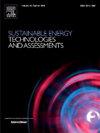Empowering the steel industry with solar: Sustainable energy for a greener future
IF 7.1
2区 工程技术
Q1 ENERGY & FUELS
Sustainable Energy Technologies and Assessments
Pub Date : 2025-04-01
DOI:10.1016/j.seta.2025.104298
引用次数: 0
Abstract
Steel manufacturing is an energy-intensive industry that grappling with rising electricity costs and substantial carbon emissions. While renewable energy is gaining attention, the integration of large-scale industrial solar photovoltaic (PV) systems remains challenging due to space constraints, fluctuating energy demands, and financial limitations. Most existing research focuses on small-scale commercial and residential solar installations. It leaves a gap in large-scale industrial systems, which require customized stringing, adaptive inverter sizing, and optimized DC/AC ratios. This research explores how to design an optimized large-scale rooftop PV system for steel manufacturing to maximize performance and profitability. The methodology involves designing and simulating a 2.8 MWp rooftop solar PV system using PVsyst software. Following this, technology selection, technical performance, economic, environmental, and sensitivity analyses were conducted. The performance ratio analysis identified a 1.43 DC/AC ratio as optimal, achieving a PR of 81.67 %. A comparative analysis between self-consumption (SELCO) and Net Offset Virtual Aggregation (NOVA) demonstrated that SELCO is the superior option, yielding RM 7.87 million in annual savings with a 9.5-month payback period. Electricity consumption of 312,417.25 kWh/month contributes to a greenhouse gas emission reduction of approximately 236.81 tons CO2-eq. The sensitivity analysis revealed that as DC voltage drop increased from 2.70 % to 3.30 %, energy output declined, leading to a simultaneous rise in DC losses from 0.78 % to 1.14 %.These findings highlighted large-scale solar PV as a viable decarbonization strategy. Additionally, the design integrates technical performance, financial, and environmental factors into a holistic framework to facilitate solar PV adoption in heavy industries.

用太阳能为钢铁工业赋能:可持续能源创造更绿色的未来
钢铁制造业是一个能源密集型行业,正在努力应对不断上涨的电力成本和大量的碳排放。虽然可再生能源越来越受到关注,但由于空间限制、能源需求波动和资金限制,大规模工业太阳能光伏(PV)系统的集成仍然具有挑战性。大多数现有的研究集中在小型商业和住宅太阳能装置上。它在大规模工业系统中留下了空白,这些系统需要定制串,自适应逆变器尺寸和优化的DC/AC比率。本研究探讨如何为钢铁制造业设计一个优化的大型屋顶光伏系统,以最大限度地提高性能和盈利能力。该方法包括使用PVsyst软件设计和模拟2.8 MWp屋顶太阳能光伏系统。在此之后,进行了技术选择、技术性能、经济、环境和敏感性分析。性能比分析确定了1.43的DC/AC比为最佳,实现了81.67%的PR。自我消耗(SELCO)和净抵消虚拟聚合(NOVA)之间的比较分析表明,SELCO是更好的选择,每年节省787万令吉,投资回收期为9.5个月。每月312,417.25千瓦时的电力消耗有助于减少约236.81吨二氧化碳当量的温室气体排放。灵敏度分析表明,当直流电压降从2.70%增加到3.30%时,输出能量下降,导致直流损耗同时从0.78%增加到1.14%。这些发现强调了大规模太阳能光伏是一种可行的脱碳策略。此外,该设计将技术性能、财务和环境因素整合到一个整体框架中,以促进重工业采用太阳能光伏。
本文章由计算机程序翻译,如有差异,请以英文原文为准。
求助全文
约1分钟内获得全文
求助全文
来源期刊

Sustainable Energy Technologies and Assessments
Energy-Renewable Energy, Sustainability and the Environment
CiteScore
12.70
自引率
12.50%
发文量
1091
期刊介绍:
Encouraging a transition to a sustainable energy future is imperative for our world. Technologies that enable this shift in various sectors like transportation, heating, and power systems are of utmost importance. Sustainable Energy Technologies and Assessments welcomes papers focusing on a range of aspects and levels of technological advancements in energy generation and utilization. The aim is to reduce the negative environmental impact associated with energy production and consumption, spanning from laboratory experiments to real-world applications in the commercial sector.
 求助内容:
求助内容: 应助结果提醒方式:
应助结果提醒方式:


